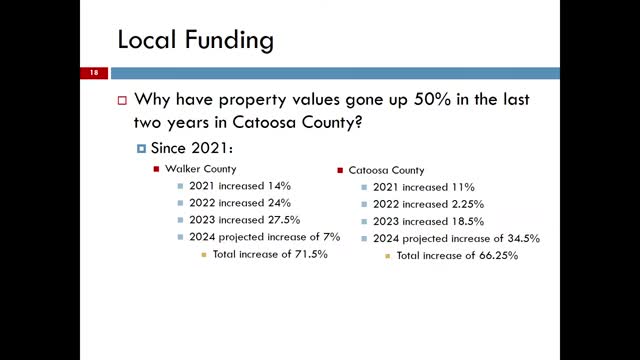School district faces budget crisis amid rising costs
August 13, 2024 | Catoosa County, School Districts, Georgia
This article was created by AI summarizing key points discussed. AI makes mistakes, so for full details and context, please refer to the video of the full meeting. Please report any errors so we can fix them. Report an error »

In a recent government meeting, officials discussed significant changes in property tax assessments and the financial implications for local schools. The meeting highlighted a 2.25% increase in property taxes for 2022, which is projected to rise to the low thirties this year. Notably, last year, the governor provided an $18,000 property tax relief grant for homesteaded properties, but no similar relief is planned for 2024 despite the state holding a record surplus.
Catoosa County's property was reported as undervalued by $750 million prior to reassessment, leading to an overall increase of approximately $800 million in the tax digest, a 34.5% rise. However, after accounting for new school tax exemptions, the net growth was reduced to $76.5 million, which is insufficient to cover new state-mandated expenses.
The current millage rate of 15.040 is the lowest since 2001, and comparisons with neighboring counties show Catoosa's rates are among the lowest. Despite this, concerns were raised about potential increases in school taxes for properties valued over $1 million, with average monthly increases projected at just under $32 for homes valued at $275,000.
The meeting also addressed rising costs due to state mandates, including significant increases in health insurance premiums for school employees, which are projected to add $3.63 million to expenses. Additionally, new requirements from the Early Literacy Act will necessitate over $1 million for curriculum changes without state funding.
Officials noted that the district's fund balance reserves have dwindled from $25 million to a projected $5 million, prompting discussions on cost-cutting measures, including the elimination of instructional and administrative positions. The board is also exploring ways to utilize funds more effectively, including the use of ESPLos funds for instructional tools.
As the district faces a projected budget deficit of $678,638, officials emphasized the importance of maintaining a millage rate that allows for continued funding while adhering to state laws regarding tax assessments and funding requirements. The meeting concluded with a commitment to transparency and public engagement as the board navigates these financial challenges.
Catoosa County's property was reported as undervalued by $750 million prior to reassessment, leading to an overall increase of approximately $800 million in the tax digest, a 34.5% rise. However, after accounting for new school tax exemptions, the net growth was reduced to $76.5 million, which is insufficient to cover new state-mandated expenses.
The current millage rate of 15.040 is the lowest since 2001, and comparisons with neighboring counties show Catoosa's rates are among the lowest. Despite this, concerns were raised about potential increases in school taxes for properties valued over $1 million, with average monthly increases projected at just under $32 for homes valued at $275,000.
The meeting also addressed rising costs due to state mandates, including significant increases in health insurance premiums for school employees, which are projected to add $3.63 million to expenses. Additionally, new requirements from the Early Literacy Act will necessitate over $1 million for curriculum changes without state funding.
Officials noted that the district's fund balance reserves have dwindled from $25 million to a projected $5 million, prompting discussions on cost-cutting measures, including the elimination of instructional and administrative positions. The board is also exploring ways to utilize funds more effectively, including the use of ESPLos funds for instructional tools.
As the district faces a projected budget deficit of $678,638, officials emphasized the importance of maintaining a millage rate that allows for continued funding while adhering to state laws regarding tax assessments and funding requirements. The meeting concluded with a commitment to transparency and public engagement as the board navigates these financial challenges.
View full meeting
This article is based on a recent meeting—watch the full video and explore the complete transcript for deeper insights into the discussion.
View full meeting
